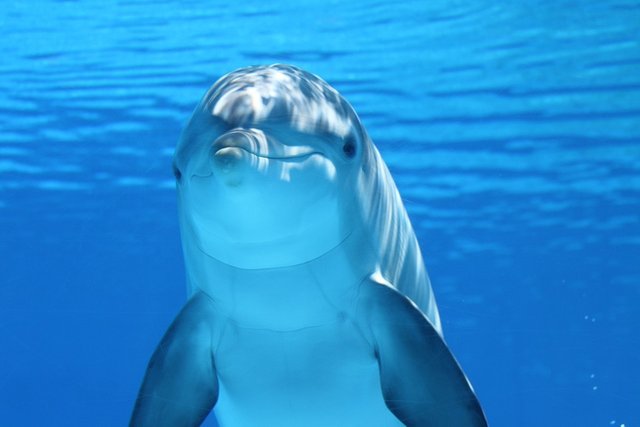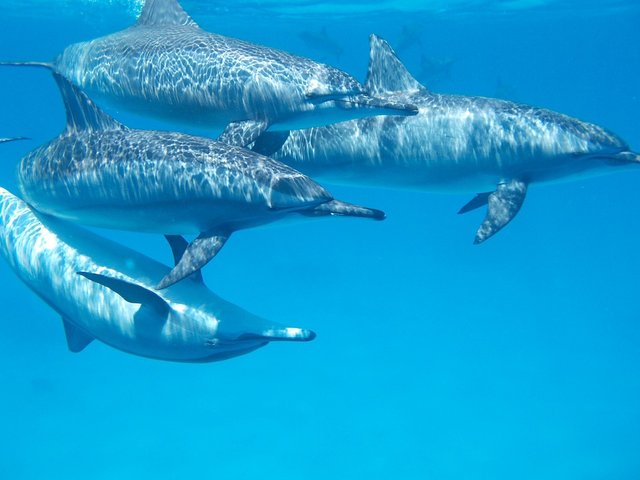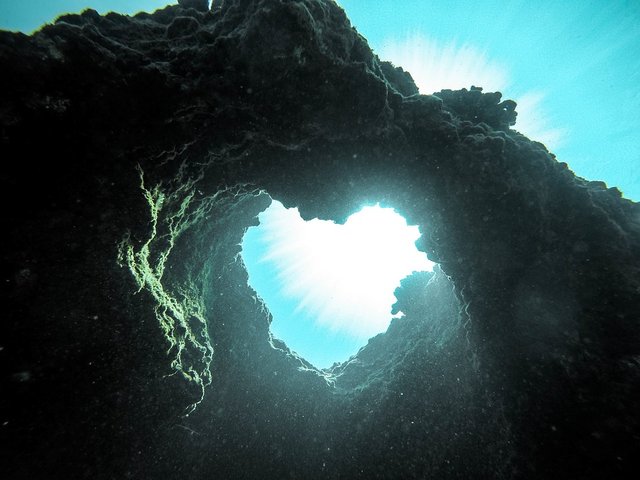Aliens in the Ocean. Understanding Cetaceans. Intelligence Part 3

Denise Herzing, founder of the Wild Dolphin Project, believes that learning to communicate with dolphins could help to prepare us for communication with intelligent life beyond our planet. At first glance dolphins do not seem like the highly intelligent animal most alien to us- like us they are medium-sized highly social mammals. As I discussed in my last post parrots are also highly intelligent, but are from a completely different taxonomic class from humans, our common ancestor last walking the earth hundreds of millions of years ago. Even so, the minds of dolphins and other cetaceans(whales, orcas etc) may prove more difficult for us to comprehend. Before we discuss just why that is, let’s discuss some of the features that humans and cetaceans share.
Points of Similarity
1. Large Brains
Together with their huge bodies, cetaceans have huge brains. The sperm whale and the orca are the heavyweight champions, with brains weighing in at an impressive maximum of 10 kg. Dolphin brains weigh in at around 1.6 kg while humans lag behind at 1.3 kg.
Luckily for us, total brain size is not the best measure of intelligence, otherwise we might be the ones getting caught in nets. A better measure is the percentage of the brain devoted to functions of higher cognition, such as abstract thinking, planning, and memory. In humans the region of the brain largely responsible for this is the neocortex, which makes up the majority of our brain. Dolphins, the most extensively studied of cetaceans, also have a very well-developed neocortex. [1]
Another useful measure is encephalization quotient (EQ), which is the ratio of an animal’s brain size compared to the expected brain size of a creature of the same size. Humans have the highest EQ of all animals at 7.4-7.8, dolphins come in second at 4.0-4.6. [2]

2. Highly Social
Another trait the most intelligence cetaceans share with humans is that they live in complex social groups. There are some problems in gaining a clear picture of the exact social interactions between cetaceans, which we will discuss further later in the article, but we do know that animals like dolphins and orcas spend years with their mothers after birth, cooperate in groups to hunt, and recognize other individuals in their group. [3] Dolphins may be part of larger groups of thousands of individuals, but often form closer bonds with two or three others. These smaller groups cooperate on tasks like finding a mate. If you have a dolphin wing man, he might be able to offer the female friend a fish while you move in on your target.
Points of Difference
1. Sight vs Sonar
Humans primarily interact with the world through our vision and spoken language. A huge proportion of the human brain is devoted to processing visual data. The visual area of the dolphin cortex is only around 1/10 the size of ours, whereas their auditory cortex is far more developed than ours. Much of Dolphin spatial understanding and the majority of communication is done through sonar- a ‘sense’ we do not even possess. [4]
When it comes to communication and the way we perceive the world, we have much more in common with birds. Birds use vision to move around, and identify attractive potential mates, followed by the use of highly complex chirps and songs. Look how successful that has been for Justin Bieber.
Dolphins and and other cetaceans communicate through clicks, hums and songs, many of which are outside the range we can hear. There is good evidence they can use echolocation to perceive things qualitatively different to what is possible for us, including whether a female is pregnant, whether a friend has eaten, or even emotional states. [5] They wouldn’t have to worry about congratulating an overweight friend on her pregnancy.

2. Different Environment.
We understand very little of the deep ocean where many cetaceans spend most of their time. I have always been amazed by the statistic that 95% of the ocean remains unexplored by humans. [6] It is difficult to judge the intelligence of a species outside of their natural environment. A jungle where parrots and apes might be found is often not the most friendly environment for us, but we can understand it for the most part. Some large whales are believed to be able to communicate across hundreds of kilometres in the deep oceans [3] . This is a world we only have small glimpses of.
3. No hands and Few Facial Muscles
One of the ways that humans were initially thought to be unique was in our ability to use tools. However it later turned out that some apes and corvids share this ability. [7] Placing a high value on tool use as a behavioral indicator of intelligence can be seen as an example of anthropomorphic bias, as tool use is clearly easier with hands. With more study however, it was discovered that dolphins do in fact use tools: dolphins have been observed carrying sponges on their snouts to protect them from cuts while digging for spiky shellfish. [3]
Dolphins and birds also lack the facial muscles necessary to show expressions that we understand. You would understand a chimpanzee screaming at you and showing its fangs, but an angry dolphin thrashing around in the water and furiously clicking at you might just seem excited. To the dolphin, those clicks might be clearly indicating that you owe him a fish. Your smile is likely to be completely meaningless to him/her.
These factors combined mean that using human-derived indicators of intelligence are likely to overestimate the intelligence of primates and underestimate the intelligence of cetaceans. Recent research has become aware of the need to make sure we are truly testing intelligence, rather than measuring the extent to which animals are able to think like humans.
Experimental Evidence
Despite the problems involved in getting large animals which live in a foreign environment to cooperate with tests, there is some solid experimental evidence of cetacean intelligence. As the smallest and (probably) the most intelligent of the cetaceans, dolphins have been the subject of most of these tests.
Self Awareness

The classic test here is the mirror test. A mark, such as a spot of paint is placed on the animal. The animal is then placed in front of a mirror, and their behavior is observed to see if they recognize that the image in the mirror is them. Dolphins can consistently pass this test. As an example, after getting marked on the tongue, one dolphin swam directly to a mirror and opened and closed its mouth many times in front of the mirror, in a way it had never been observed doing before.[5]
Source:Pixabay
This kid just failed the mirror test
Pointing and Understanding the Need for Attention
When dolphins want to show their trainers something, they can ‘point’ to it. They do this by swimming towards the object, stopping a few metres away, then repeatedly angling their head towards the object. They seem to understand the need for the human to be paying attention to them, and do not perform this behavior when no humans are present.[7]
Complex Social Relationships
Unfortunately the data here does not reach the standard of experimental evidence. Difficulties in communication and observation mean that it is difficult to gain conclusive evidence of how complex dolphin relationships might be. However there is some evidence that dolphins use distinctive sounds for members of their group, meaning that they may use names just as we do. It also seems that in the wild, where dolphins organize themselves into larger groups, some individuals seem to act as ‘brokers’ carrying information and communicating between the two groups. [4]
Conclusion
Decades of research on animals as different from ourselves as birds or dolphins has given us the understanding that manifestations of higher intelligence such as problem-solving, abstract thinking, and an understanding of language are not unique to humans. Rather, we are the high point of a continuum. Understanding what different minds in the animal kingdom are capable of improves our understanding of our own minds, and brings us closer to an understanding of what the necessary components of advanced cognition are.
REFERENCES
Dolphins are one of my favorites animal, and it is amazing how smart can they be.
A few years ago I read that in some parts of the world, humans use to hunt with the help of dolphins and that helped in developing a good relationship between both species.
Here is one article reporting this fact.
And there is also a cool video that shows a dolphin laughing after watching a human do a funny act :)
Thanks for the link, might use it for my next post. I think dolphins realize that we are similar to them, they might be able to 'see' inside our bodies to tell that we are warm-blooded. maybe in the future we can communicate with them more, there is a project happening right now to develop a shared language between humans and dolphins.
This is such a good educational article that you can consider joining the @steemiteducation community. Steemiteducation does upvote selected quality articles and also members in discord give support to one another for their educational articles! Good effort for this article!
Thanks very much, I will come over and take a look
Pretty smart those dolphins... but not as smart as this guy...
Hahaha
Smarter than me maybe, I was trying to figure out what he gets if he makes the lever go down. There was some food in the end? I guess Kea's aren't good enough at flying to just hover over it and grab it
Hey. I think the food is in the middle of the pipe. She/he can only get it when it is inclined down to the right, otherwise it is in the middle of the pipe. Super smart, these kea. Ravens can do the same thing apparently and a couple of other parrots. Smarter than me too :) - Cheers!
Ah yeah that make sense. Good to see my favourite bird is up there with the ravens and other parrots
I was interested in the sonar vs. sound section. Sounds travel differently in water-- the speed of sound in water is much greater than the speed of sound in air. So, the highly developed auditory senses of a dolphin are the kind of adaptation that humans make when they are deprived of sight. I don't think this bears on intelligence at all, just adaptation. Or maybe that was the point you were making. Anyway, got me thinking and reading. Very interesting blog.
Thanks AG:) There is a theory that the neocortex basically does one thing- pattern recognition. That could be visual patterns, auditory patterns, patterns in 20 digit number multiplication or basically anything else. It can adapt to do almost anything the organism needs early in life. This book discusses it, it's a great read.
Thanks! Sounds fascinating.
Truly, the cordial relationship between humans and dolphins is quite admirable. It would be fascinating if the science or technology of communicating in logical terms with them can be pulled off, with time. Great share @flyyingkiwi
Yeah, I think the dolphins might be able to say quite a lot if we could speak their language. I'm off to watch a TED talk about that topic now, I think I have one more dolphin post in me!
You just got a Team NZ upvote!


This is a curation bot for TeamNZ. Please join our AUS/NZ community on Discord.
For any inquiries/issues about the bot please contact @cryptonik.
Resteemed by @resteembot! Good Luck!
Check @resteembot's introduction post or the other great posts I already resteemed.